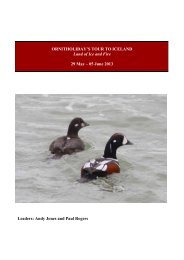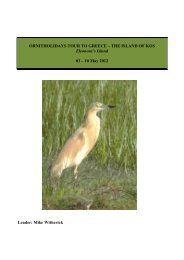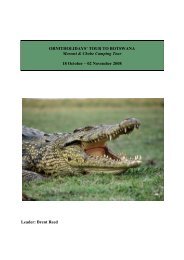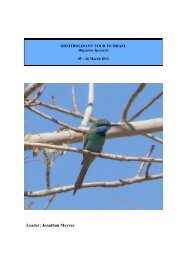Download 2014 Brochure (.pdf) - Ornitholidays
Download 2014 Brochure (.pdf) - Ornitholidays
Download 2014 Brochure (.pdf) - Ornitholidays
You also want an ePaper? Increase the reach of your titles
YUMPU automatically turns print PDFs into web optimized ePapers that Google loves.
S PA I N<br />
Spain – Aragon<br />
Cranes, Lammergeiers & Wallcreepers<br />
Saturday 08 November – Saturday 15 November <strong>2014</strong><br />
Principal Leader: Steve West<br />
<strong>2014</strong> Cost: £1,599 single room supplement £100<br />
Madrid<br />
Gallocanta<br />
Lécera<br />
Loarre<br />
Barcelona<br />
ovember sees the gathering of thousands of Common Cranes at their single most important<br />
SPAIN<br />
Nstopover site in Western Europe. These birds breed in the swamps and marshes of<br />
Scandinavia, Finland and Russia. Some will be making a short stop on their southward migration,<br />
which will take them to the dehesas of Extremadura, while others will stay around Gallocanta to<br />
benefit from the safe haven provided by the lagoon and the food available in the surrounding fields.<br />
We shall be treated to one of the world’s great spectacles as these birds fly in large flocks overhead,<br />
trumpeting as they go. Our local guide Steve West will also help us explore some great habitats where we can look for some of the special birds of<br />
Spain. Who cannot be tempted when there is mention of Dupont’s Lark, Bonelli’s Eagle, Lammergeier, Wallcreeper, Black Woodpecker and Citril<br />
Finch We stay at three very comfortable and well located hotels. At this time of year the day length is getting shorter and the birds are active, feeding<br />
up before winter arrives. This tour is packed with some great birds and some little-visited locations. Why not travel with Steve and see why we think<br />
this itinerary is such a winner.<br />
ITINERARY<br />
Days 1 & 2<br />
We leave London, or regional airports, on a flight<br />
to Madrid, where we collect our mini-buses and<br />
transfer to our hotel at Gallocanta, where we stay<br />
for two nights. In the morning we will look for the<br />
flocks of Common Cranes, and it would take a<br />
hard-hearted naturalist not be thrilled by the<br />
sights and sounds of flock after sonorous flock<br />
of Common Cranes flying overhead to and from<br />
the lagoon, and etching their slender silhouette<br />
on the skyline above this high plateau. The<br />
lagoon of Gallocanta itself doesn’t always<br />
contain much water, but when it does it is home<br />
to a variety of ducks and waders, which may<br />
include Red-crested Pochard, Black-necked<br />
Grebe and Kentish Plover. The surrounding<br />
open steppe-type farmland holds a regular<br />
population of Calandra and Crested Larks and<br />
the occasional Black-bellied Sandgrouse.<br />
Raptors are often noteworthy, and in the course<br />
of a day it would not be unusual to see species<br />
such as Golden Eagle, Hen Harrier, Eurasian<br />
Griffon Vulture, Merlin, Western Marsh Harrier<br />
and Red Kite.<br />
Days 3 & 4<br />
We take leave of Gallocanta and its cranes today<br />
to make full contact with the best steppes in<br />
northern Spain. But let’s not rush things: first of<br />
all we should take a look at some of the relatively<br />
unknown countryside lying between us and our<br />
next hotel in Lécera, where we stay for two<br />
nights. By doing so we increase our chances of<br />
seeing certain avian gems such as Bonelli’s<br />
Eagle and Black Wheatear, along with a rich<br />
supporting cast including the likes of Rock<br />
Sparrow, Cirl Bunting, Blue Rock Thrush, Crag<br />
Martin, Red-billed Chough and Dartford Warbler,<br />
to name just a few. Whispers from the past break<br />
through the solitude of the River Martin area:<br />
steep-walled gorges hold Neolithic cave<br />
paintings, rock-loving birds and even small<br />
numbers of Spanish Ibex. It’s not surprising to<br />
learn that Eurasian Eagle Owls haunt these<br />
parts, although it would be more so to actually<br />
see one of these magnificent birds in the<br />
daytime!<br />
The next day we make an early start, which is welljustified,<br />
as a dawn visit to the steppes of Belchite<br />
to see the sun rise over the rolling plains is a mustsee<br />
experience, especially if accompanied by<br />
good chances of seeing the rare and elusive<br />
Dupont’s Lark. That can be a difficult undertaking,<br />
but even if we do not set eyes on this rare bird we<br />
Pin-tailed Sandgrouse<br />
114<br />
For a previous tour report or further information please call: 01794 519445








